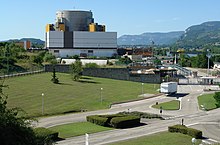Pengguna:Aimwin66166/Kotak pasir/reaktor nuklear
Reaktor Nuklear
- Liquid metal fast-breeder reactor (LMFBR) [moderator: none; coolant: liquid metal]

- This totally unmoderated reactor design produces more fuel than it consumes. They are said to "breed" fuel, because they produce fissionable fuel during operation because of neutron capture. These reactors can function much like a PWR in terms of efficiency, and do not require much high-pressure containment, as the liquid metal does not need to be kept at high pressure, even at very high temperatures. These reactors are fast neutron, not thermal neutron designs. These reactors come in two types:

- Lead-cooled
- Using lead as the liquid metal provides excellent radiation shielding, and allows for operation at very high temperatures. Also, lead is (mostly) transparent to neutrons, so fewer neutrons are lost in the coolant, and the coolant does not become radioactive. Unlike sodium, lead is mostly inert, so there is less risk of explosion or accident, but such large quantities of lead may be problematic from toxicology and disposal points of view. Often a reactor of this type would use a lead-bismuth eutectic mixture. In this case, the bismuth would present some minor radiation problems, as it is not quite as transparent to neutrons, and can be transmuted to a radioactive isotope more readily than lead. The Russian Alfa class submarine uses a lead-bismuth-cooled fast reactor as its main power plant.
- Sodium-cooled
- Most LMFBRs are of this type. The TOPAZ, BN-350 and BN-600 in USSR; Superphénix in France; and Fermi-I in the United States were reactors of this type. The sodium is relatively easy to obtain and work with, and it also manages to actually prevent corrosion on the various reactor parts immersed in it. However, sodium explodes violently when exposed to water, so care must be taken, but such explosions would not be more violent than (for example) a leak of superheated fluid from a pressurized-water reactor. The Monju reactor in Japan suffered a sodium leak in 1995 and could not be restarted until May 2010. The EBR-I, the first reactor to have a core meltdown, in 1955, was also a sodium-cooled reactor.
- Lead-cooled
- Molten salt reactors (MSR) [moderator: graphite, or none for fast spectrum MSRs; coolant: molten salt mixture]
- These dissolve the fuels in fluoride or chloride salts, or use such salts for coolant. MSRs potentially have many safety features, including the absence of high pressures or highly flammable components in the core. They were initially designed for aircraft propulsion due to their high efficiency and high power density. One prototype, the Molten-Salt Reactor Experiment, was built to confirm the feasibility of the Liquid fluoride thorium reactor, a thermal spectrum reactor which would breed fissile uranium-233 fuel from thorium.
- Aqueous homogeneous reactor (AHR) [moderator: high-pressure light or heavy water; coolant: high-pressure light or heavy water]
- These reactors use as fuel soluble nuclear salts (usually uranium sulfate or uranium nitrate) dissolved in water and mixed with the coolant and the moderator. As of April 2006, only five AHRs were in operation.[1]
- ^ "RRDB Search". nucleus.iaea.org.